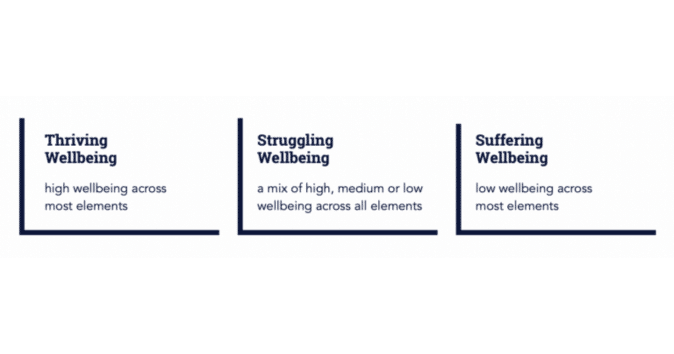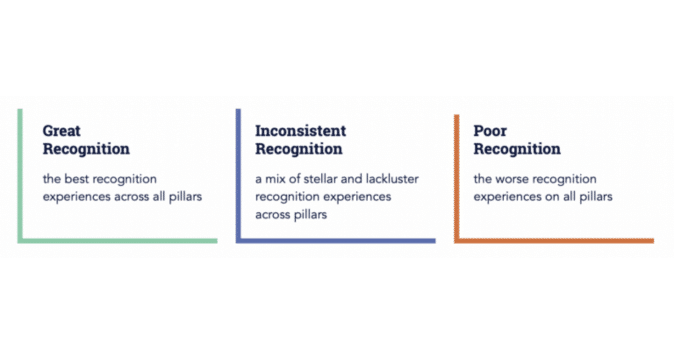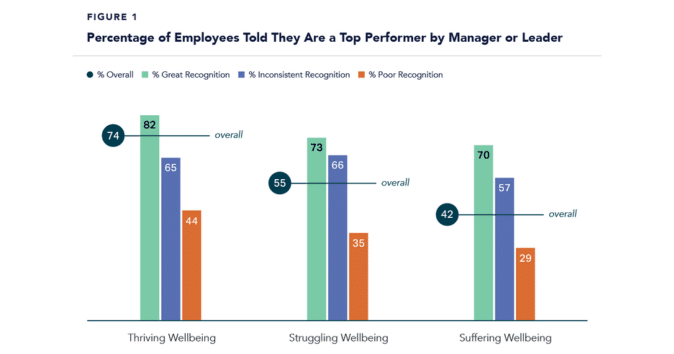How Does Recognition Improve Employee Wellbeing and Performance?
It’s no secret that employee wellbeing and performance are inextricably linked. Think about it: When you’re feeling your best, it follows that you’d produce your best work.
But it isn’t quite as simple as that.
New research from Gallup and Workhuman shows that the U.S. workforce is on the precipice of a tragic workplace wellbeing crisis. Employees are struggling with stress, burnout, and loneliness like never before – in fact, four in 10 U.S. employees say their job is negatively impacting their mental health.
You read that right: Forty percent of Americans who showed up – or signed on – to work today are struggling more in life because of it.
So, what are organizations doing about it?
The short answer: Not enough.
Fewer than one in four employees Gallup surveyed say their organization cares about their wellbeing (nearly half the number who said the same before the COVID-19 pandemic rocked the workplace), signaling there is considerable room for improvement if organizations want to see their greatest asset – their people – fully invested in their work.
The current state of employee wellbeing should be a red flag, particularly with trends like quiet quitting (now loud quittingOpens in a new tab) growing in size and scope.
It’s time for business leaders and managers to consider – and implement – the innovative and research-backed solutions we know will help. This isn’t a cliché call-to-action; it’s a reminder of the woefully untapped tool that every person reading this sentence has at their disposal: employee recognition.
Let’s look at the ways recognition can improve employee wellbeing, including both physical and mental health, and job performance across your organization:
The synergy between recognition and employee wellbeing
In previous Gallup and Workhuman research, we established that recognition and employee health and wellbeing are connected. This large-scale study shows that fulfilling recognition is associated with better employee wellbeing across four key dimensions:
- Increased overall life evaluations: Employees are as much as 2X as likely to evaluate their lives and futures more positively.
- Reduced levels of burnout: Employees are up to 90% less likely to report being burned out at work “always” or “very often.”
- Improved daily emotions: Employees are up to 2X as likely to report having experienced a lot of gratitude the previous day and about 40% less likely to report having experienced a lot of stress, worry, and sadness.
- Better social wellbeing: Employees are 7X as likely to strongly agree that they have meaningful connections or a best friend at work, and as much as 10X as likely to strongly agree that they belong.
So, what does all of this mean for your organization? That it’s time to start prioritizing recognition and wellbeing, together.
High wellbeing prepares employees to excel in everything they do. Employees with high wellbeing perform better and lead happier, more fulfilled lives at the office and otherwise. And, when recognition is part of wellbeing efforts, the outcomes and ROI are extraordinary.
It’s a no brainer, isn’t it?
But, consider this as an even bigger workplace imperative: The Gallup and Workhuman research shows the costs of neglecting workplace wellbeing are real and significant:
- $20 million of opportunity loss for every 10,000 workers due to low wellbeing and its drain on performance.
- $322 billion cost globally in turnover and lost productivity when low wellbeing shows up as employee burnout.
This data from our previous Gallup and Workhuman study was so compelling, we decided to dig a little deeper in our latest analysis to understand how the intricate connections between recognition and wellbeing can pave the way for better business outcomes and thriving workplaces.
What Defines Wellbeing?
Through decades of researchOpens in a new tab, Gallup has identified five key elements that contribute to people’s thriving, struggling, or suffering in life:
- Career wellbeing: Refers to how people spend their days and whether or not they generally like what they do with their time.
- Social wellbeing: Refers to people’s relationships with others and whether or not they have meaningful connections and positive interactions with others.
- Financial wellbeing: Refers to people’s economic stability and standard of living and whether or not they have the funds they need to provide for themselves and/or their family.
- Physical wellbeing: Refers to people’s health and physical condition and whether or not they have the energy and endurance to be productive each day.
- Community wellbeing: Refers to people’s daily environment and whether or not they feel satisfied, connected, and engaged with the areas in which they live.
To summarize how people are doing in their life overall, Gallup asked more than 10,000 working adults in the U.S. how they view their lives, then bucketed people into three different wellbeing levels that differentiate how their lives are really going:

What Defines Strategic Recognition?
Next, we turned our attention to Gallup and Workhuman’s five pillars of strategic recognition (i.e., more than the reactive and occasional “thank you”):
- Fulfilling employees’ recognition expectations: The amount you receive makes sense.
- Authentic: It isn’t just a “checklist” thing.
- Personalized: It’s given fairly, without playing favorites.
- Equitable: One size doesn’t fit all.
- Embedded in organizational culture: It’s integrated into the day-to-day.
Gallup studied the same group of 10,000 U.S. working adults to identify three recognition categories that describe the types of praise, appreciation, acknowledgement, and thanks people are receiving at work:

The next step with the research was to analyze how recognition and wellbeing influence each other – and what happens when organizations prioritize one without focusing on the other.
To do this, we looked at the roles recognition and employee wellbeing play in key employee experiences – like workplace performance.
The relationship between employee wellbeing and performance
In this latest Gallup and Workhuman analysis, we asked survey respondents the question: “Has your manager or leader told you that you are a top performer?
For employees with thriving wellbeing (wellbeing that is strong in the five key elements described above), 74% of those surveyed report they have been told they are a top performer.
Just over half (55%) of employees with struggling wellbeing (a mix of high, medium, or low wellbeing across most elements) report the same, and the percentage of employees with suffering wellbeing (low wellbeing across most elements) is even lower: 42%.
We see a similar and strong pattern with employee recognition.
Seventy-six percent of employees with great recognition experiences (the best recognition experiences across all five of Gallup’s pillars of strategic recognition, described above) have been told they’re a top performer.
What’s more, employees with great recognition experiences are also more likely to be thriving in their lives overall (72%).
Conversely, 63% of employees with inconsistent recognition experiences (a mix of stellar and lackluster experiences across all recognition pillars) are told they’re a top performer.
Even more alarming, just 33% of employees with poor recognition experiences (the worst recognition experiences across all recognition pillars) are told they’re a top performer.
You might be wondering: Are the people with poor recognition experiences just not that great at their jobs?
This is where a robust recognition strategy comes in – because people should be recognized for more than just the quality of their work.
The Workhuman and Gallup research shows employees who receive recognition for life events and workplace milestones – both unrelated to performance – are 3X as likely to strongly agree their organization cares about their wellbeing than those who don’t.
In short: When employees’ wellbeing is struggling or suffering, recognition matters even more.
The impact of employee wellbeing on workplace performance
In our research, we found that, across the U.S., 54% of employees have been told by a manager or leader that they’re a top performer at work. Employees who have suffering wellbeing are told they’re a top performer at a significantly lower rate: 42%.
However, when suffering employees have great recognition experiences, they are told they’re a top performer at a rate of 70%.
Here’s where things take a turn for the worse: Employees who have thriving wellbeing but poor recognition experiences are much less likely to be told they’re a top performer than their peers with better recognition experiences.
Only 44% of thriving employees with poor recognition experiences have been told they’re a top performer at work (compared with 74% of thriving employees overall who have been told they’re a top performer, when recognition is not considered).

Consider the figure above, where the rate of employees being told they’re a top performer remains at 70% or higher for people with great recognition experiences, regardless of their wellbeing level.
In other words, recognition is buffering the damaging effects of low wellbeing on employees’ likelihood they will be called a top performer by management or leadership.
Strategies to improve employee wellbeing and workplace performance
The return on investment is clear: When employees have thriving wellbeing and are receiving the best recognition experiences possible, they’re more likely to be told they’re a top performer. That’s a massive opportunity to improve business outcomes by empowering employees with recognition.
So, the question becomes: What can you do to simultaneously increase employee wellbeing and recognition?
As the Workhuman and Gallup data shows, leveraging the two together plays a key role in driving employee performance.
Link wellbeing and recognition strategies:
Review your existing programs or practices before making any changes. Is your organization all-in on wellbeing, but sub-par on recognition? What about the opposite?
Empower your managers:
While everyone in the workplace is responsible for giving recognition and encouraging wellbeing among their peers, managers play a pivotal role in establishing these as key parts of the workplace culture. Educate every manager on the importance of recognition and wellbeing – and underscore the important synergy between the two.
Executives lead the way:
Whether it’s recognizing someone for their good work on a project or implementing policies to prioritize work-life balance, employees are watching what their leaders are doing and taking note.
Create opportunities to celebrate healthy habits:
Life gets busy. And it can be hard for employees to prioritize their personal wellbeing. Show support for your employees by helping them put their health first.
Consider implementing company-wide wellbeing challenges that include opportunities for employees to recognize one another’s efforts. These initiatives will not only promote employee engagement, but will foster a culture of wellbeing and recognition.
Final Thoughts
At a time where employee wellbeing across the U.S. is teetering on the edge of disaster, it’s time to get serious about making impactful changes.
The latest Workhuman and Gallup research shows a powerful connection between strategic employee recognition and wellbeing – and how the two, together, take employee performance to a whole new level.
The question to ask yourself is: What steps are you actively taking, today, to improve wellbeing and employee performance?
About the author
Stacy Thompson
Stacy Thompson is senior director of content strategy & activation at Workhuman. A lover of language, Stacy focuses on bringing company stories to life from ideation to execution. A Midwestern native, Stacy lives in Billerica, MA with her husband, two kids, and two cats – and spends her time outside of work running, skiing, writing, reading, and yoga-ing.